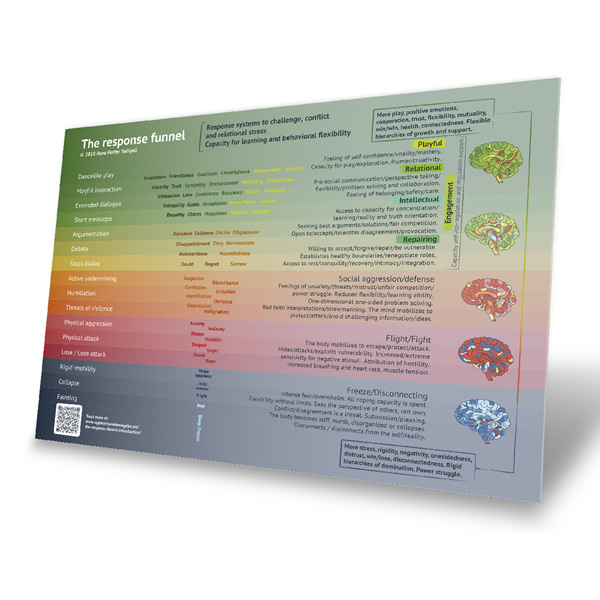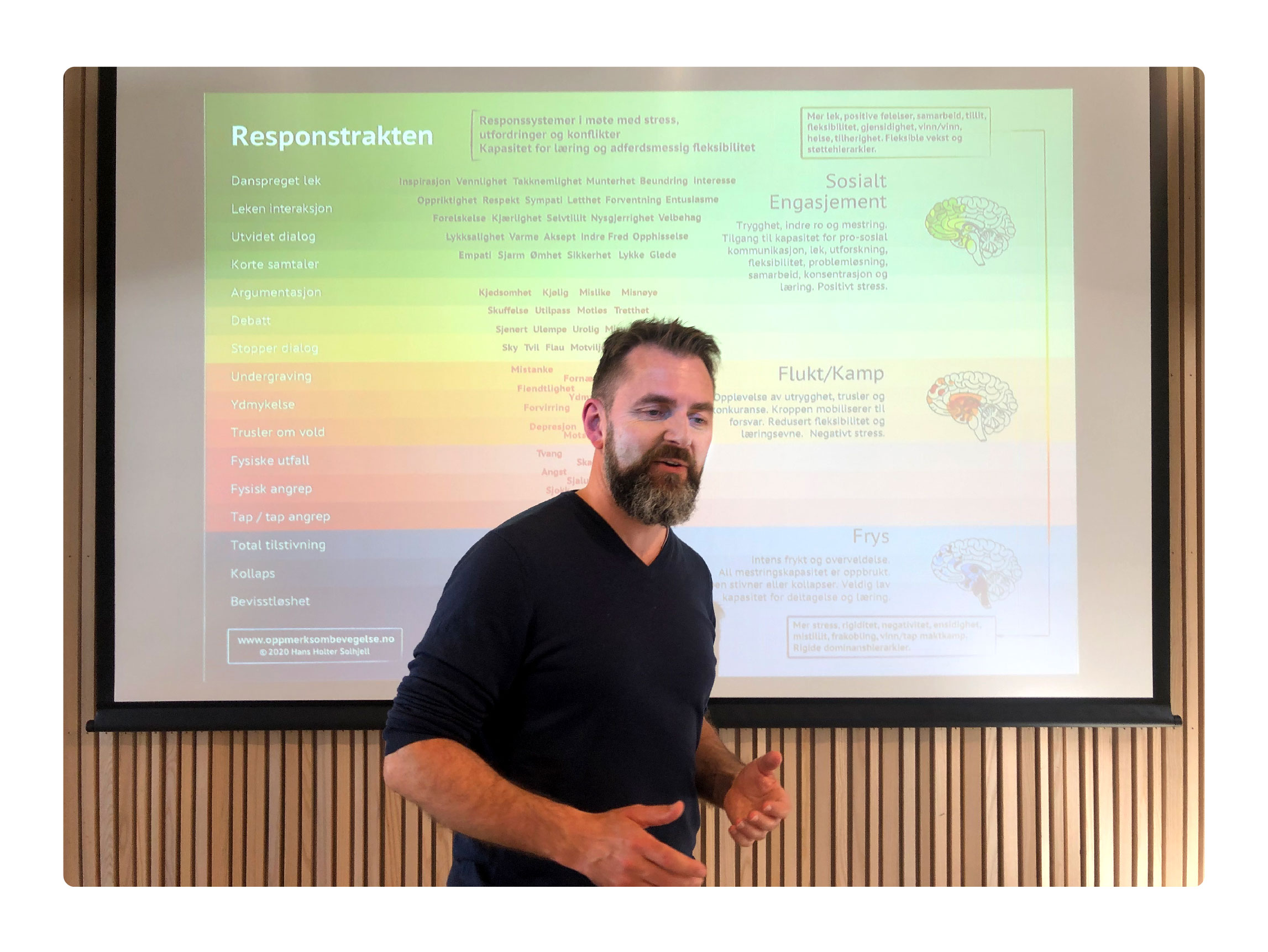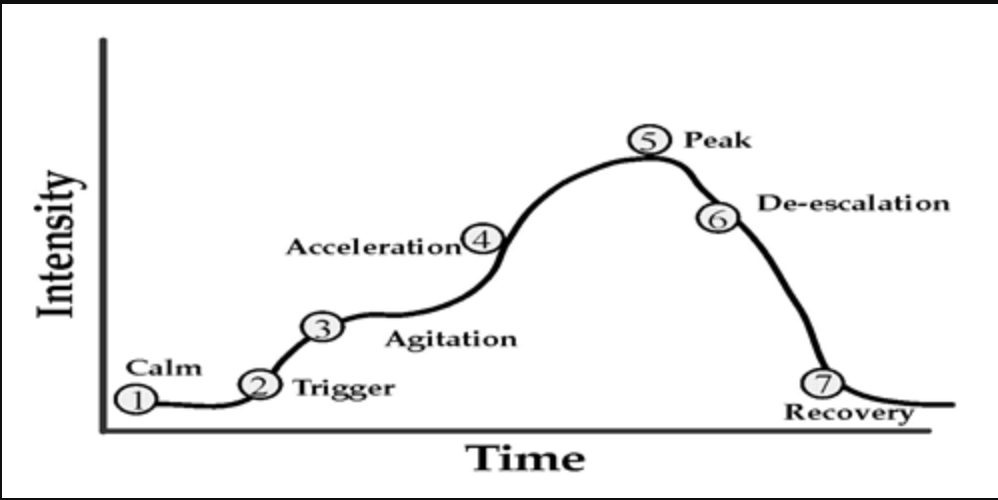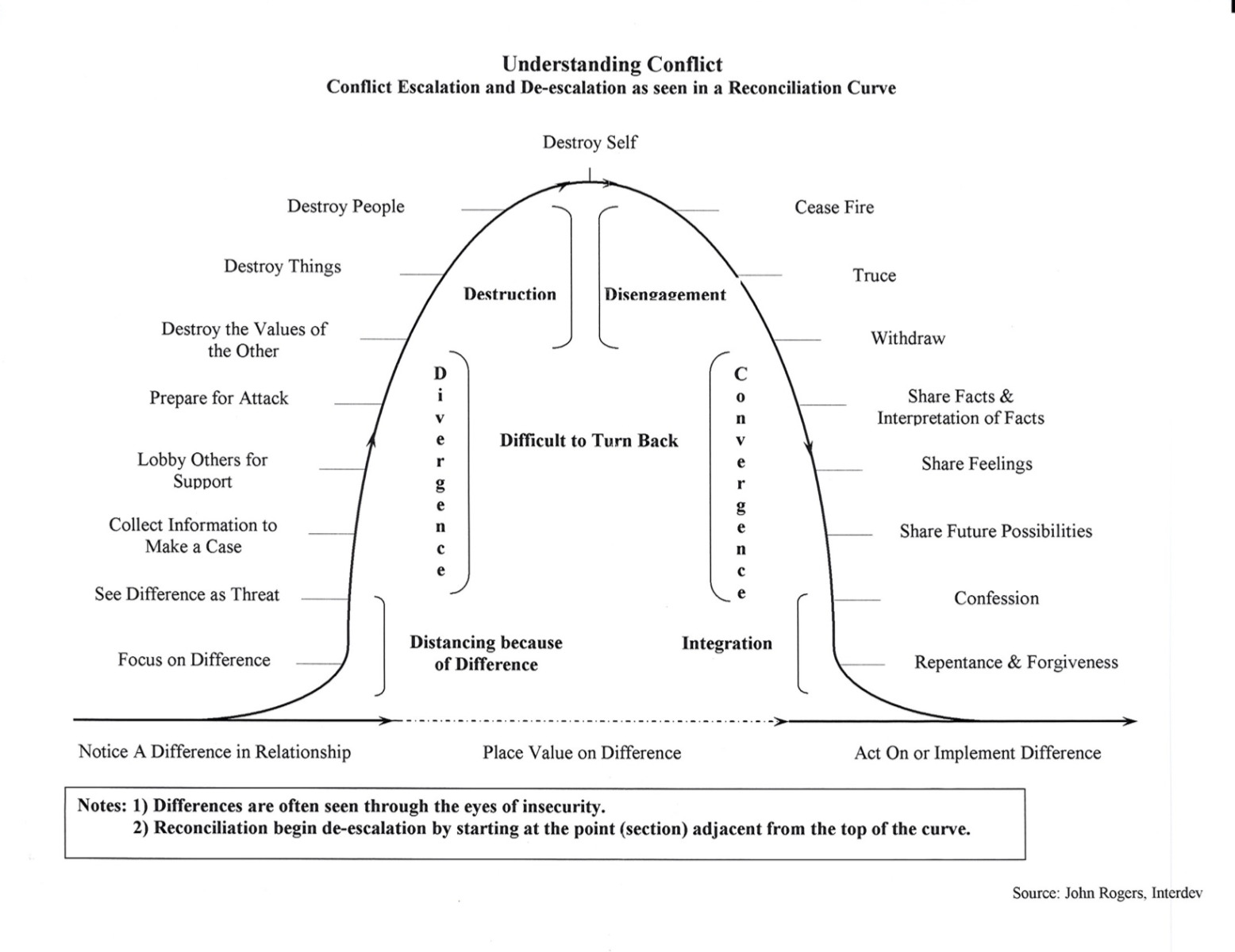Article by Hans Holter Solhjell.
Published September 30th. 2020.
Part 2 of a series of articles about the response funnel.
You can read part one of the article about The Response Funnel here.
The Response Funnel Model is now also translated into more languages.
Please see this page for a complete list of languages.
The Response funnel model;
conceptual and theoretical aspects
In the second article on the response funnel model, I provide an overview of the conceptual understanding the model is based on and include and compare it to some other related models in this field.

Download The Response Funnel model here!
The Response Funnel is a new and innovative model in the field of trauma, conflict resolution, relationships, and self-development.
To receive information about The Response Funnel please register for our newsletter. You will then receive a free copy of The Response Funnel.
The model was Created for use in the context of relationships, parenting, developmental support, communication, and conflict resolution.
The response funnel was developed in the practical context of relationships, communication and conflict resolution, parenting, and developmental support.
Its purpose is to explain the concept of regulation-support and its importance for short-term conflict resolution, joint task completion, and long-term child development.
The model is then then used, applied together with the PLS regulation- support model, to teach how, we, as responsible adults, can provide regulation-support in relationships with children.
Articles about PLS regulation support model and related courses are in the process of being translated to English. If you are interested you can fill in the form on this page and we will alert you when the articles are available.
Additionally the purpose of creating the model was to help adults see clearly where, on the behavior scale, both ourselves and the child are acting. And to explain how we as adults can act in a more regulation-supportive manner, and support children’s development of self-regulation and socio-emotional skills over time.
Furthermore, the model is useful for similar purposes in other contexts, like trauma therapy, in relationships, and conflict resolution in general. It can also be used to map and understand some aspects of what occurs in communication in organizations, politics, society, and culture at large.
The map/illustration is not the territory.
There are many ways of presenting and designing illustrations regarding the topics included in the response funnel, and indeed any topic. Like a map of certain terrain, any illustration, model or theory will illuminate some aspects of the field it covers and hide others. Also, they are created based on a set of ideas, intentions, and principles that might be more or less conscious to the author and designer.
No one map can contain all information or serve all purposes. One map of the same area might be more precise, useful, or relevant for some purposes, and another map for other purposes. This is also the case for illustrations of ideas. There is no one optimal way of illustrating a concept that serves all purposes.
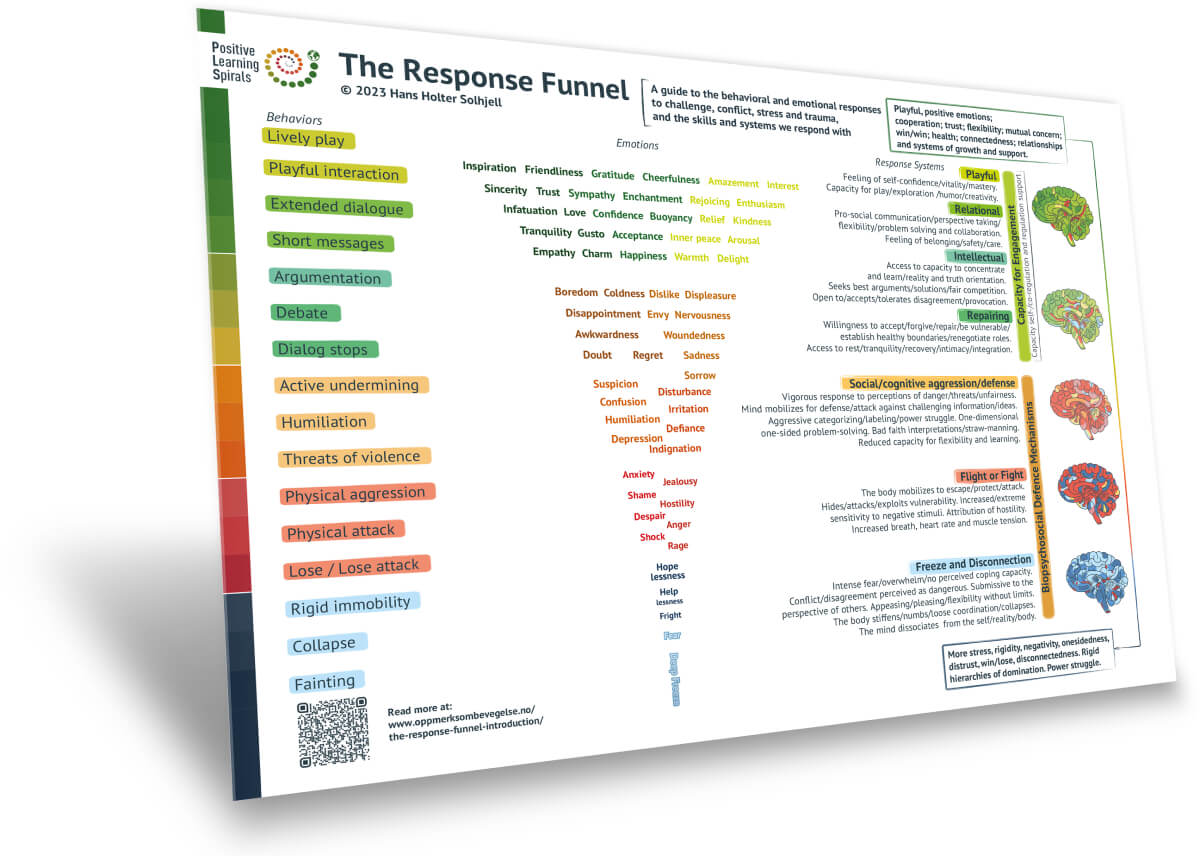
Using the response model visualization as an example, in some instances, I prefer to use it with the green area on top. For other purposes, I use it with the green field at the bottom, depending on what is suitable in the context, use with other models, etc.
Other maps/illustrations of the same territory.
There are several other models that to some degree have influenced the development of the response funnel, and that illuminates different aspects of the same “territory” that the response funnel maps.
I will briefly mention conflict escalation illustrations from conflict theory and conflict resolution, the window of tolerance model, and the polyvagal curve based on Stephen Porges Polyvagal theory. The purpose is to cite these models as sources of inspiration for the development of the response funnel model and illustrate the differences in conceptualization and practical use.
Conflict escalation curves
There is a long tradition of using illustrations within the field of conflict theory and for the teaching of conflict resolution skills.
The conflict escalation curves typically use a curve to illustrate the escalation and de-escalation in conflicts and general descriptions of intensity and stages of a conflict. These are two examples:
For the primary purpose of the Response funnel model, the idea of escalation and de-escalation is central, but a curve is not used.
Rather, the emotional funnel metaphor, the colored levels, the lists to the right and the left, and the brains to the right is used concurrently to illustrate the escalation and de-escalation.
When used in combination with the PLS regulation support model (a phased conflict resolution model) a curve as well as phase descriptions is also used, and the green SES field is placed at the bottom.
Numerous models for conflict and conflict resolution for a broad range fields and types of conflicts have been developed. I have collected some links to various examples of these, that also have very interesting and useful illustrations. You will find these links by clicking the box.
Links:
https://itmconflictmgmt.com/making-sense-of-conflict/escalation-de-escalation/
https://issat.dcaf.ch/Share/Blogs/ISSAT-Blog/The-Case-for-SSR-as-a-Conflict-Prevention-Measure
https://www.researchgate.net/figure/Conflict-Intensity-Frame_fig1_40112175
https://thirdside.williamury.com/what-is-the-third-side/three-opportunities/
The list of behaviors on the left is originally adapted from Friedrich Glasl’s model of conflict escalation, with some of the terminology adapted to the field of caregiver-child relationships. Glasl’s model has nine levels, corresponding to the nine levels in the response funnel from argumentation to loose-loose attack.
Image of Glasl’s nine levels of conflict escalation. (Source https://en.wikipedia.org/wiki/File:Glasl%27s_Model_of_Conflict_Escalation.svg)
You can read more about Friedrich Glasl’s model of conflict escalation on its Wikipedia page, here.
Within the field of caregiver-child relationships, few models of conflict and conflict resolution seem developed. Neither have I found any models of conflict that integrate knowledge and perspectives on optimal developmental support and positive states.
Glasl’s 9 steps start at argumentation, and in a context (optimal development) where we want to include more information about positive states, skills, and regulation support, this is insufficient.
In the response funnel model, these higher-level states and skills are included in the upper part of the green section, in the four top items from short messages to dancelike play. Information and inspiration for items in this section have been quite hard to find.
The first source of inspiration I have used is Basil Bernstein’s ideas about language coding, the restricted and the elaborated code, corresponding to the items short messages and extended dialogue in the left column.
The second source of inspiration has been Patricia M. Crittenden’s Care Index, and its two top scores, 14-13: mutual, pleasurable, dancelike playful interaction and 11-12: mutual, soft, pleasant, playful interaction. These are adapted at the two top levels of the list as playful interaction and dance-like play.
In addition, more generally, literature and research about the importance of play, here exemplified by the book “Play: How it Shapes the Brain, Opens the Imagination, and Invigorates the Soul” by Dr. Stuart Brown has inspired this addition.
Similarly, few if any models of conflict include knowledge and perspectives from the field of trauma theory and therapy, which would be the blue field at the bottom of The Response Funnel model with various levels of the freeze mechanism indicated. These are well described in the trauma literature, with some variations. For the choice of freeze, collapse, and faint as item words I used an article by H. Stefan Bracha as inspiration.
The Response Funnel model also includes a perspective on the brain and the body, alluded to by the brain illustrations on the right.
Window of tolerance
The window of tolerance illustrations tend to emphasize symptoms of stress, hyper or hypo arousal, and typically suggest various strategies for self-regulation, like mindfulness, etc.
In the “window of tolerance” illustrations the middle part is the area of the “tolerance window”. In my opinion, this makes it less useful to illustrate the escalation and de-escalation dynamics of conflicts, but still works well for other purposes, like explaining self-regulation in a trauma-related context.
Here is one good example, by Marie S. Dezelic.
Polyvagal curve
The various Polyvagal curve illustrations, based on the work of Stephen Porges, typically name the same symptoms of stress as the window of tolerance, but put more emphasis on describing the physiology related to stress and trauma, primarily related to the vagus nerve, and use an activation and deactivation curve, much similar to typical conflict theory curves.
But rather than conflict intensity, escalation and de-escalation, the poly-vagal curve illustrates physiological activation, and the emphasis of the models is mostly focused on physiological factors. This is one example.
A map of subjectively observable behaviors, emotions, and learnable skills.
The focus or the aspect of the territory that is highlighted by the basic version of the response funnel is our outwardly and inwardly subjectively observable communicative, behavioral, and emotional responses, typically occurring in conflict and other challenging situations, and less on the underlying biological mechanisms.
The main focus of the response funnel model is on what is subjectively and intersubjectively observable, within and outside our self, using our regular senses, in ongoing real-life situations, and less on factors that can not be observed or acted directly upon in real life situations, like various aspects of our internal anatomy.
Expanded versions of the model (coming soon) have a much broader focus, including a more comprehensive range of communicative, cognitive, and bodily actions. It also puts emphasis on learnable attitudes, skills, and processes that support real-life mastery.
The model does not rely on any particular view of the brain or nervous system.
It is common for models illustrating topics related to stress and trauma to focus on physiology, the brain, the autonomic nervous system, etc.
While the the brain illustrations used in the model alludes to the importance of our biology, the development of the response funnel, although also inspired by biological models, obviously acknowledging that our physiology, the brain, and nervous system is fundamentally important to our capacity for self-regulation, co-regulation, and regulation-support, the purpose and usage of the response funnel model is not dependent on in-depth knowledge about physiology. Nor does it require a specific point of view or particular understanding of how our brain in conjunction with other parts of our biology functions.
There are several competing theories on how the various parts of our physiology function and interact. For instance, how the brain and our nervous system work, concerning how these influence and impact our emotions and stress-related responses.
The three main levels in the illustration, green, red, and blue, and the idea of the Social Engagement System, SES on top above fight/flight and freeze, was initially based on the polyvagal theory as well as Paul Maclean’s triune brain model. In previous versions of the model the top green field was labeled as “Social Engagement System”.
In later developments of the model I have moved away from the clear connection to these models and theories, and moved my focus more toward the practical closer to subjective experience and observable behaviors. In addition I have chosen terms that give the model an increased practical value from the perspective of conflict resolution and developmental support.
Another highly interesting theory of the brain and emotion is the constructionist theory of emotions, exemplified here by the research and theory of Lisa Feldman Barret, in her book “How emotions are made”. The response funnel model fits equally well, or possibly even better, with Barret’s constructionist theory. A practical concept she presents in her books is the idea of emotional granularity.
Emotional granularity describes our capacity to differentiate between different emotions in ourselves and others, and according to Barret higher emotional granularity also increases our general social and life skills and functioning.
I adapted and applied the idea of granularity to other aspects of our communication and behavior, with the lists on the right and the left. One goal of the model is to help us more clearly see where we are at with our communication and therefore also possibly adjust it better to the needs of the situation, including ourselves. Assisting us to see from where we are operating, both concerning ourselves and other individuals involved in the current interaction process.
The detailed understanding of biology and the use of terminology that is useful in brain science and neurology is less useful, from a daily practical need perspective, in the context of conflict resolution, etc, which The Response Funnel model is focused on. It can still be highly interesting and serve other purposes, like a deepening of understanding, in an overall process of learning about these topics.
In the next part of this article series on the response funnel model more of the theories that influenced the development of the response funnel model will be presented. (In production)
You can download a basic version of the response funnel here.
Register for our newsletter and receive a copy of The Response Funnel.
If you are interested in more information about the response funnel model you can register for our newsletter. You will then receive a copy of The Response Funnel.
In our newsletter, you will receive information about new developments of The Response Funnel as well as our related courses and training programs.

Global Response Funnel Translation Project
Do you want to participate in the Global Response Funnel Translation Project, and help translate the model? Please read more about the project here.
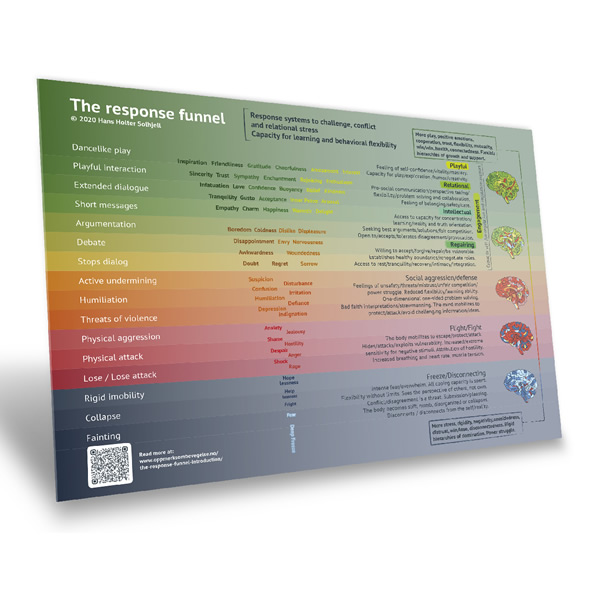
Buy high-quality prints and support our work
Only available in Norwegian at this time. Coming soon in English. Please register your interest in our interest form to receive a notification when the English version is available.
It is possible to buy high-quality prints of the model in A4 and A3 format. This helps to support our work to develop the model further, translate it into more languages, and to share this information globally.
Only available in Norwegian at this time. Coming soon in English. Please register your interest in our interest form to receive notification when the English version is available.

